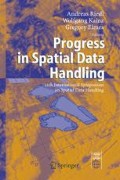Abstract
Current navigation services assume wayfinders new to an environment. In contrast, our focus is on route directions for wayfinders who are familiar with the environment, such as taxi drivers and couriers. We observe that people communicate route directions to these wayfinders in a hierarchical and granular manner, assuming some shared knowledge of the environment. These route directions do not focus on the route but rather on the destination. In this paper we solve the first problem of automatically generating route directions in a hierarchical and granular manner: finding the initial entity of such a communication. We propose a formal model to determine the initial entity, based on Grice’s conversational maxims, and applied to a topological hierarchy of elements of the city. An implementation of the model is tested for districts in a political subdivision hierarchy. The tests show a reasonable behavior for a local expert, and demonstrate the efficiency of granular route directions.
Access this chapter
Tax calculation will be finalised at checkout
Purchases are for personal use only
Preview
Unable to display preview. Download preview PDF.
References
Clark HH, Wilkes-Gibbs D (1986) Referring as a Collaborative Process. Cognition 22:1–39
Couclelis H (1996) Verbal directions for way-finding: Space, cognition and language. In: Portugali J (ed) The Construction of Cognitive Maps. Kluwer, Dordrecht, pp 133–153
Dale R (1992) Generating Referring Expressions: Constructing Descriptions in a Domain of Objects and Processes. ACL-MIT Series in Natural Language Processing. MIT Press
Denis M, Pazzaglia F, Cornoldi C, Bertolo L (1999) Spatial Discourse and Navigation: An Analysis of Route Directions in the City of Venice. Applied Cognitive Psychology 13:145–174
Edmonds PG (1994) Collaboration on Reference to Objects that are Not Mutually Known. In: 15th Int Conf on Computational Linguistics, COLING-94, Kyoto, pp 1118–1122
Frank A (2003) Pragmatic Information Content: How to Measure the Information in a Route Description. In: Duckham M, Goodchild M, Worboys M (eds) Foundations of Geographic Information Science. Taylor & Francis, London and New York
Freundschuh SM, Mark DM, Gopal S, Gould MD, Couclelis H (1990) Verbal directions for wayfinding: Implications for navigation and geographic information and analysis systems. In: Brassel K, Kishimoto H (eds) 4th Int Symp on Spatial Data Handling. Department of Geography, University of Zurich, pp 478–487
Grice P (1975) Logic and Conversation. In: Cole P, Morgan JL (eds) Speech Acts. Academic Press, New York, pp 41–58
Heeman PA, Hirst G (1995) Collaborating on Referring Expressions. Computational Linguistics 21(3):351–382
Hirtle S (2003) Neighborhoods and Landmarks. In: Duckham M, Goodchild M, Worboys M (eds) Foundations of Geographic Information Science. Taylor & Francis, London and New York, pp 191–203
Hirtle S, Jonides J (1985) Evidence of Hierarchies in Cognitive Maps. Memory and Cognition 13:208–217
Jarvella RJ, Klein W (eds) (1982) Speech, Place, and Action. John Wiley & Sons, Chichester, NY
Klein W (1979) Wegauskünfte. Zeitschrift für Literaturwissenschaft und Linguistik 33:9–57
Klippel A, Tappe H, Habel C (2003) Pictorial Representations of Routes: Chunking Route Segments During Comprehension. In: Freksa C, Brauer W, Habel C, Wender KF (eds) Spatial Cognition III — Routes and Navigation, Human Memory and Learning, Spatial Representation and Spatial Learning (= Lecture Notes in Artificial Intelligence 2685). Springer-Verlag, Berlin, pp 11–33
Lovelace KL, Hegarty M, Montello DR (1999) Elements of Good Route Directions in Familiar and Unfamiliar Environments. In: Int Conf on Spatial Information Theory: Cognitive and Computational Foundations of Geographic Information Science. Springer-Verlag, pp 65–82
Lynch K (1960) The Image of the City. The MIT Press, Cambridge, Massachusetts, USA
Newman EL, Caplan JB, Kirschen MP, Korolev IO, Sekuler R, Kahana MJ (2005) Learning Your Way Around Town: Virtual Taxicab Drivers Reveal the Secrets of Navigational Learning. Cognition, in press
Paraboni I, Deemeter K van (2002) Generating Easy References: the Case of Document Deixis. In: Second Int Conf on Natural Language Generation (INLG 2002), New York, USA
Peterson J, Chitil O (2005) Haskell.org — The Haskell Home Page. Available http://www.haskell.org (visited on May 15, 2005)
Plumert JM, Carswell C, de Vet K, Ihrig D (1995) The Content and Organization of Communication about Object Locations. J of Memory and Language 37:477–498
Plumert JM, Spalding TL, Nichols-Whitehead P (2001) Preferences for Ascending and Descending Hierarchical Organization in Spatial Communication. Memory and Cognition 29(2):274–284
Shannon CE, Weaver W (1949) The Mathematical Theory of Communication. The University of Illinois Press, Urbana, Illinois
Shanon B (1979) Where Questions. In: 17th Annual Meeting of the Association for Computational Linguistics. University of California at San Diego, La Jolla, California, USA, ACL
Sperber D, Wilson D (1986) Relevance. Basil Blackwell Ltd, Oxford, UK
Timpf S, Volta G, Pollock D, Egenhofer MJ (1992) Conceptual Model of Wayfinding Using Multiple Levels of Abstraction. In: Frank A, Campari I, Formentini U (eds) Theory and Methods of Spatio-Temporal Reasoning in Geographic Space (= Lecture Notes in Computer Science 639). Springer-Verlag, Pisa, Italy, pp 348–367
Tversky B (1993) Cognitive Maps, Cognitive Collages, and Spatial Mental Models. In: Frank A, Campari I (eds) Spatial Information Theory: A Theoretical Basis for GIS, COSIT’ 93 (= Lecture Notes in Computer Science 716). Springer, Berlin, pp 14–24
Weissensteiner E, Winter S (2004) Landmarks in the Communication of Route Directions. In: Egenhofer MJ, Miller H, Freksa C (eds) Geographic Information Science 2004 (= Lecture Notes in Computer Science 3234). Springer, Berlin, pp 313–326
Wiener JM, Mallot HA (2003) ‘Fine-to-Coarse’ Route Planning and Navigation in Regionalized Environments. Spatial Cognition and Computation 3(4):331–358
Worboys M (2003) Communicating Geographic Information in Context. In: Duckham M, Goodchild M, Worboys M (eds) Foundations of Geographic Information Science. Taylor & Francis, London and New York, pp 33–45
Author information
Authors and Affiliations
Editor information
Editors and Affiliations
Rights and permissions
Copyright information
© 2006 Springer-Verlag Berlin Heidelberg
About this chapter
Cite this chapter
Tomko, M., Winter, S. (2006). Identification of the Initial Entity in Granular Route Directions. In: Riedl, A., Kainz, W., Elmes, G.A. (eds) Progress in Spatial Data Handling. Springer, Berlin, Heidelberg . https://doi.org/10.1007/3-540-35589-8_4
Download citation
DOI: https://doi.org/10.1007/3-540-35589-8_4
Publisher Name: Springer, Berlin, Heidelberg
Print ISBN: 978-3-540-35588-5
Online ISBN: 978-3-540-35589-2
eBook Packages: Earth and Environmental ScienceEarth and Environmental Science (R0)

